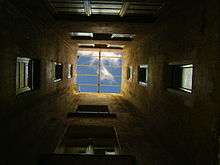Lightwell
In architecture, a lightwell, light well or air shaft is an unroofed external space provided within the volume of a large building to allow light and air to reach what would otherwise be a dark or unventilated area. Lightwells may be lined with glazed bricks to increase the reflection of sunlight within the space.

Lightwells serve to reduce the necessity for electric lighting, add a central space within the building, and provide an internal open space for windows to give an illusion of having a view outside.
Area or areaway
A subterranean lightwell at the front of a building to provide light to a basement is called an area (or areaway in North American usage).
Ancient history
The lightwell was used in ancient civilizations, such as the Egyptians[1] and at the Palace of Knossos on Minoan Crete.[2] There are also instances of lightwell use by the Romans.[3]
See also
| Wikimedia Commons has media related to Lightwells. |
References
- Bagnall, Roger S; Frier, Bruce W (2006). The demography of Roman Egypt. Cambridge, New York: Cambridge University Press. ISBN 978-0-521-46123-8. OCLC 28927049.
- Hogan, C Michael (2008-04-14). "Knossos". The Modern Antiquarian. Retrieved 2008-05-24.
- Higginbotham, James Arnold (1997). Piscinae: Artificial Fishponds in Roman Italy. Chapel Hill, NC: University of North Carolina Press. ISBN 978-0-8078-2329-3. OCLC 35172558.
